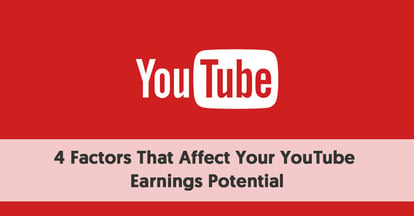We look at the 4 factors that influence your Youtube Earnings Potential. Try out the Youtube Money Calculator to estimate your potential earnings at the bottom of this post.
Factors that determine your Income Potential on YouTube
CPM vs CPC
There are two important acronyms that you might hear in relation to YouTube advertising - CPM and CPC.
Although you can choose both types of ad on your YouTube channel, the most visible are embedded videos.
Estimated Gross Earnings Per 1,000 Views
Our YouTube Money Calculator focuses on those videos that you embed at the start of your video. It can give an estimated range of earnings for a selected number of views. The actual amount paid varies, depending on a number of factors, including the popularity of your channel and the actual income that Google receives from specific advertisers.
Some of the reasons for this variation include the category your video falls into, the season (for example, Christmas ad rates are high) your language, country, competition for advertising spots and various other factors.
Estimated Earnings Per Subscriber
Although YouTube traditionally kept its share of advertising income secret, it is now common knowledge that Google keeps 45% of YouTube advertising revenue. So you receive 55% of every dollar paid by advertisers (which is less than the 68% that website owners receive for most other types of Google Adsense advertising).
The estimated earnings that the average YouTube creator could expect to receive from ads on a new video on their channel if EVERYBODY watched the ad on their video and the advertiser paid the average $7.60 CPM is 55% x $7.60, equaling $4.18 per 1,000 views. Of course, success breeds success. Once a channel is recognized as being worth watching, its subscription numbers are likely to rise rapidly. It is likely that at least 10% of a channel’s subscribers will want to view any new videos it uploads. A channel with only 1,000 subscribers will only have a base of 100 people likely to return to look at their new videos. However, once the channel raises its subscription numbers to 1,000,000, they will probably receive views from 100,000 subscribers shortly after uploading any new video.
Also, YouTube favors the most popular channels when it comes to serving ads with high CPM rates. As your subscriber base rises, so should your average CPM.
Estimated Variance Based on Video Engagement
However, there is one major limiting factor that severely limits the income a video creator can receive from the ads served on its YouTube channel. Human nature! In reality, most people who watch videos skip past the ads. If they do that, they are not considered by YouTube or Google to be viewers for payment purposes. In practice, only 15% of video watchers on average watch at least 30 seconds of an advertising video, which officially counts as being a view. This percentage undoubtedly depends on the subject matter of your channel and the nature of your subscriber base. Thus, for every 1,000 views of an average video, 150 people on average watch enough of the embedded ad to earn you advertising revenue.
If you can educate or encourage a higher percentage of your subscribers to sit through the ads at the start of your videos, it will have a huge impact on the amount of money you receive. It helps immensely if your videos and the ads on them target the same demographic.
Alternative Supplementary Income Streams
In How To Make Money On YouTube we looked at the different ways that you can make money from your YouTube Channel. Although advertising is probably the best-known method, it is often not the most lucrative. Certainly, the top YouTubers, such as PewDiePie, make a high percentage of their income from alternative sources. The problem for the average YouTuber, however, is that most of these other methods require you to be already known and have a large subscriber base.
1. Affiliate Marketing
A possible exception to the need to be a huge channel to make money is if you position your channel in a niche selling products using affiliate marketing. Here you have a chance to earn sales income. If people come here specifically with the intent of watching reviews or product tests, they are likely to consider buying the product, giving you a commission. In this case, you probably don’t need a gigantic subscriber base. You could review a particular product in your video, providing an affiliate link for those people interested in purchasing the product in the description beneath your video.
Affiliate marketing rates vary by company and product. The best-known company involved in this is Amazon. They pay percentage affiliate fees for many products (e.g. if somebody clicks your link and goes on to buy a television from them Amazon will pay you 2% of the sales price). Some YouTube channels, particularly those known for product reviews, earn far more from affiliate sales than they do from advertising.
2. Sponsorship
If your site is large enough to interest potential influence marketers, then you should be able to charge somewhere in the range of $10,000 per 100,000 views, which breaks down to $100 per 1,000 views - substantially more lucrative than advertising revenue alone.
3. Influencer Marketing Networks
You could choose to join an Influencer Marketing Network, such as Famebit or Grapevine. These companies specialize in finding appropriate influencers to help brands deliver their message. They help brands find the best channels for them. Famebit, for instance, accepts video creators with as few as 5,000 followers joining up for their services. Of course, you have to be in a very niche area to make much money from so small a following.
If Famebit accepts your site, you bid for brands’ campaigns. For instance, you might choose to bid $100 for sponsorship from a particular brand. It the brand accepts your bid, they pay you that agreed price less 10% which Famebit keeps.
In Grapevine’s case, you need at least 10,000 subscribers to your channel to participate. They have a calculator on your site to determine the best price to charge potential brand sponsors, based on a recommended formulae (which assumes that you base your calculation on a CPM of $20 - $30). If brands accept your offer, you earn at a substantially better rate than advertising alone.
For a more in-depth look at your own earning potential and other youtuber's estimated earnings then head over to our Youtube Calculator for an in depth look at your channel's potential. For a quick overview use the widget below:



